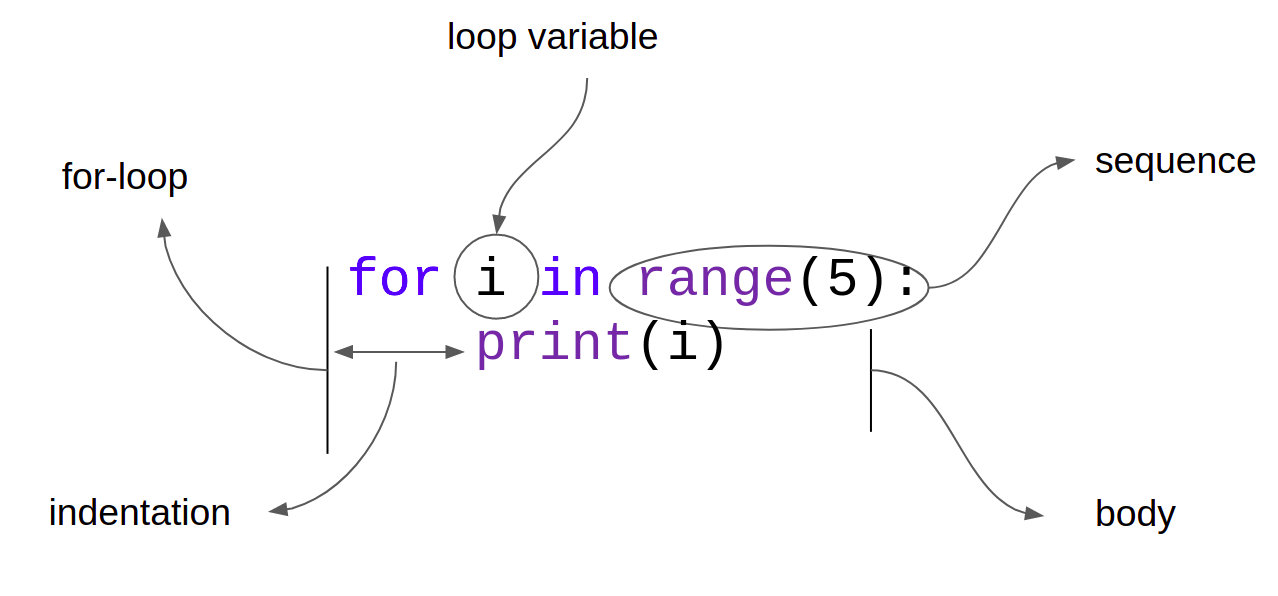
Home Lesson-3.3
Lesson-3.2
Loops
for loop
Let us look at a simple problem of printing numbers. We would like to print the first 5 non-negative integers. We have a different kind of a loop now, the for loop:
xxxxxxxxxx31for i in range(5):2 print(i)3# A dummy lineThe output is:
xxxxxxxxxx51021324354
for and in are keywords in Python. range is an object that represents a sequence of numbers. Line-2 is the body of the loop. An intuitive understanding of the code given above is as follows:
- In each iteration of the loop, an element in the sequence is picked up and is printed to the console.
- Assuming that the sequence is ordered from left to right, the leftmost element is the first to be picked up.
- The sequence is processed from left to right.
- Once the rightmost element has been printed to the console, control returns to line-1 for one last time. Since there are no more elements to be read in the sequence, the control exits the loop and moves to line-3.
A visual representation is given below:

Similar to while loops and if-else blocks, the body of a for loop should be indented.
range()
range(5) represents the following sequence: 0, 1, 2, 3, 4. In general, range(n) represents the sequence: 0, 1, ..., n - 1. range is quite versatile. The following code prints all two digit numbers greater than zero:
xxxxxxxxxx21for i in range(10, 100):2 print(i)range(10, 100) represents the sequence 10, 11, ..., 99. In general, range(start, stop) represents the sequence start, start + 1, ..., stop - 1. Let us add another level of complexity. The following code prints all even two digit numbers greater than 0:
xxxxxxxxxx21for i in range(10, 100, 2):2 print(i)range(10, 100, 2) represents the sequence 10, 12, ..., 98. In general, range(start, stop, step) represents the sequence start, start + step, start + 2 * step, ..., last, where last is the largest element in this sequence that is less than stop. This is true when the step parameter is positive.
The following are equivalent:
range(n)range(0, n)range(0, n, 1)
So far we have seen only increasing sequences. With the help of a negative step size, we can also come up with decreasing sequences. The following code prints all two-digit even numbers greater than zero in descending order:
xxxxxxxxxx21for i in range(98, 9, -2):2 print(i)For a negative step value, range(start, stop, step) represents the sequence start, start + step, start + 2 * step, ..., last, where last is the smallest element in the sequence greater than stop.
Now, consider the following code:
xxxxxxxxxx21for i in range(5, 5):2 print(i)range(5, 5) is an empty sequence. So, the above code will not print anything. Another instance of an empty sequence:
xxxxxxxxxx21for i in range(10, 5):2 print(i)The point to note is that neither of these code snippets produces any error. Finally, try executing the following snippet and observe the output.
xxxxxxxxxx41##### Alarm! Wrong code snippet! #####2for i in range(0.0, 10.0):3 print(i)4##### Alarm! Wrong code snippet! #####
Iterating through Strings
Since a string is a sequence of characters, we can use the for loop to iterate through strings. The following code will print each character of the string x in one line:
xxxxxxxxxx31word = 'good'2for char in word:3 print(char)The output is:
xxxxxxxxxx41g2o3o4d
We can add some more code to enrich the output:
xxxxxxxxxx51word = 'good'2count = 13for char in word:4 print(char, 'occurs at position', count, 'in the string', word)5 count = count + 1The output is:
xxxxxxxxxx41g occurs at position 1 in the string good2o occurs at position 2 in the string good3o occurs at position 3 in the string good4d occurs at position 4 in the string good